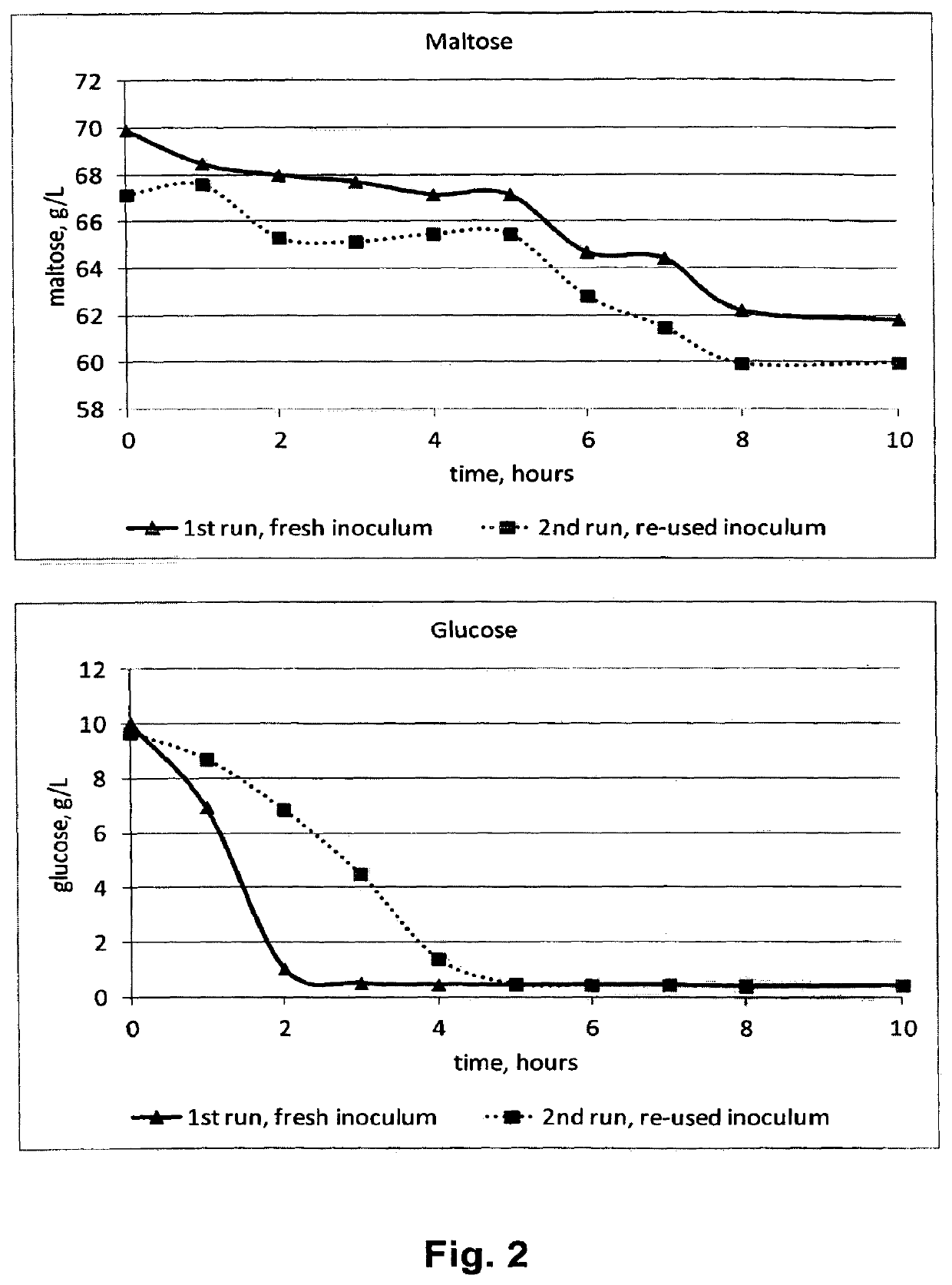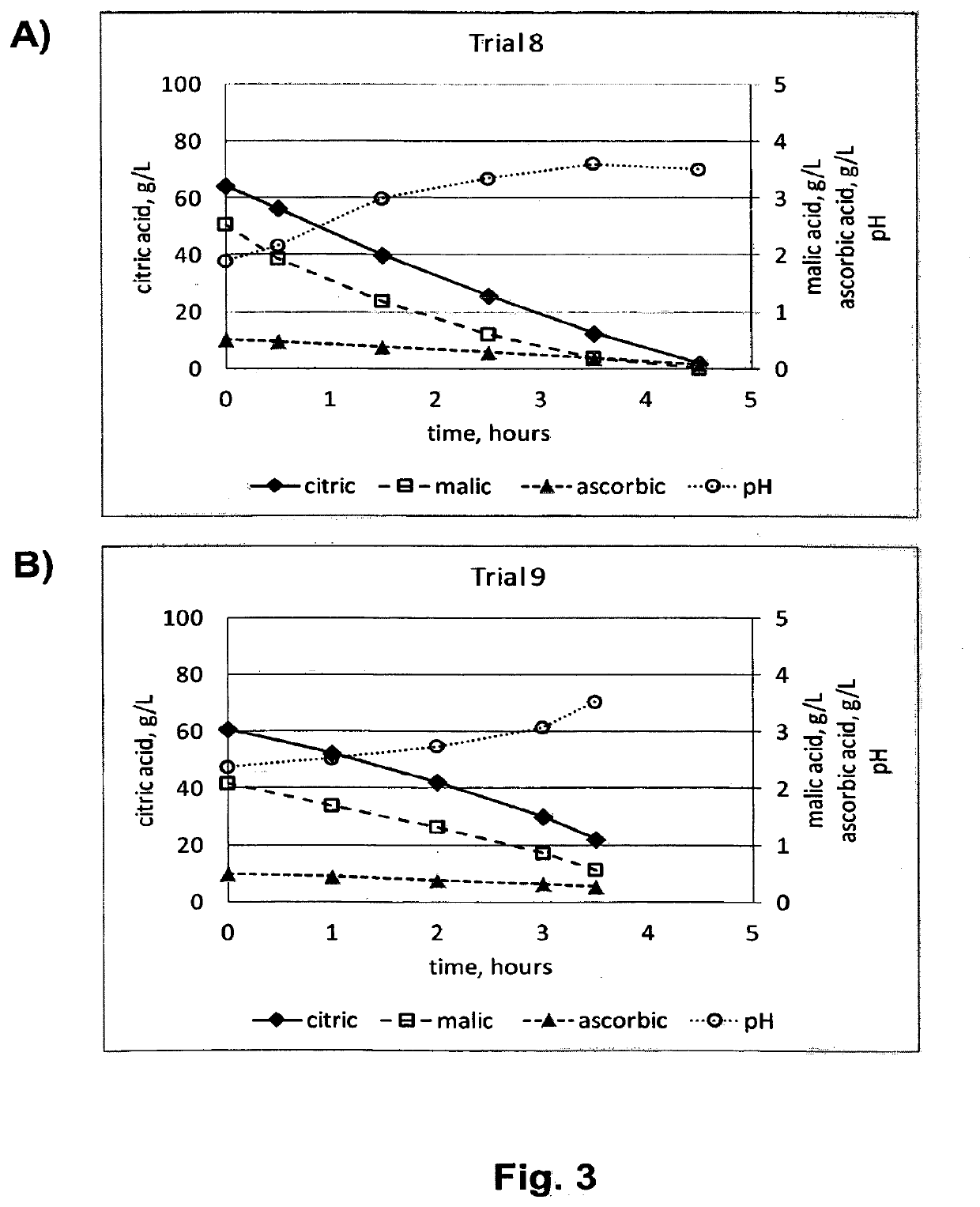Method for producing beverages by acid removal
a technology of acid removal and beverage, applied in the field of beverages, can solve the problems of restricting the use of prior art methods and removing glucose levels, and achieve the effects of low calories, low sugar content, and high beneficial micro-nutrient conten
- Summary
- Abstract
- Description
- Claims
- Application Information
AI Technical Summary
Benefits of technology
Problems solved by technology
Method used
Image
Examples
example 1
[0753]Standard wort of 14,85%P was produced as described herein below in Example 3. 7,5 L standard wort was fermented, at 30° C., by a mixture of Lactobacillus sanfranciscensis and Lactococcus lactis in a REED rig (Jurag Separation, Denmark). The REED rig was equipped with both an AX-REED and a CX-REED membrane stack. After fermentation to an end-point of pH 3.9, the ferment was allowed to stand at 4° C. for 36 hours, after which the bulk of the liquid was decanted from the sedimented bacteria. Similar tests with each of the bacteria alone were conducted. The supernatants were filtered through a Seitz EK filter, carbonated, pasteurised, and their flavour evaluated. Lactic acid bacteria were harvested by centrifuging the sediment at 8000 rpm for 10 minutes, and then left for a further 36 hours before repeating the REED controlled fermentation. The consumption of maltose and glucose by the bacteria in the first and second fermentations is depicted in FIG. 2.
[0754]Although the maltose ...
example 2
[0756]This example describes production of a fermentation process for wort, which does not produce alcohol, but adjusts the sweetness to acidity imbalance in this raw material, to produce a refreshing drinks base, which is rich in natural vitamins and minerals, and low in calories.
[0757]The resulting drinks base can be used as a beverage per se or various flavor compounds can be added before consumption.
[0758]Lactobacillus sanfranciscensis was cultivated in medium containing maltose as the only carbon source. The maltose was labeled with 13C NMR. It was shown that Lactobacillus sanfranciscensis was unable to form glycolytic metabolites from glucose when immediately transferred to this carbon source. Lactococcus lactis, which cannot grow on maltose, when fed 13C-labelled glucose, rapidly produces NMR signals which are attributable to glycolytic metabolites.
[0759]The provision of maltose, 13C-labelled on the reducing end, to a mixture of Lactobacillus sanfranciscensis and Lactococcus ...
example 3
[0760]Production of Wort
[0761]A standard wort of 14.5% P was produced from 39.8 kg of a standard Pilsner malt, which was mashed-in with 108.4 L standard brewing water at 65° C. Just after mixing milled malt with water, a commercial enzyme preparation containing an arabinoxylanase activity was added in order to facilitate filtration of the finished wort. Calcium chloride was also added at this stage, and pH was adjusted to ca. 5,4 by addition of phosphoric acid. After 60 minutes at 65° C., the temperature was gradually increased to 78° C. during a 15-minutes period, and finally kept at 78° C. for 5 minutes. The mash was then filtrated and sparged, resulting in a total volume of 212 L prior to boiling. The wort was adjusted to pH ca. 5.2 by addition of phosphoric acid, and calcium chloride was added. The wort was then boiled 70 minutes. During this period, ca. 5% water evaporated, leaving 200 L boiled wort. After a whirlpool process to remove sediments, the boiled wort was filled into...
PUM
 Login to View More
Login to View More Abstract
Description
Claims
Application Information
 Login to View More
Login to View More - R&D
- Intellectual Property
- Life Sciences
- Materials
- Tech Scout
- Unparalleled Data Quality
- Higher Quality Content
- 60% Fewer Hallucinations
Browse by: Latest US Patents, China's latest patents, Technical Efficacy Thesaurus, Application Domain, Technology Topic, Popular Technical Reports.
© 2025 PatSnap. All rights reserved.Legal|Privacy policy|Modern Slavery Act Transparency Statement|Sitemap|About US| Contact US: help@patsnap.com



